Research on Overburden Movement Characteristics of Large Mining Height Working Face in Shallow Buried Thin Bedrock
Abstract
1. Introduction
2. The Experimental Methods
2.1. Field Measurement Plan Design
2.2. Physical Simulation Experiment
2.2.1. Physical Mechanics Parameter Determination
2.2.2. Physical Simulation Scheme
2.3. Numerical Simulation Modeling
3. Roof Structural Shape Measured Results
3.1. The Law of Mining Resistance in No. 22201 Working Face
3.2. Evolution of Roof Breaking Angle
3.3. Analysis of Roof Movement Characteristics
4. Physical Simulation Experiment Results
4.1. Law of Overlying Strata Movement
4.2. FAP Distribution Characteristics and Observation of the Overburden
5. Numerical Simulation Results
5.1. The Law of Overlying Strata during the First Weighting
5.2. The Law of Overlying Strata during the Period Weighting
6. Conclusions
Author Contributions
Funding
Acknowledgments
Conflicts of Interest
References
- Huang, Q.X. Study on roof structure and ground control in shallow seam longwall mining; China University of Mining and Technology press: Xuzhou, China, 2000. [Google Scholar]
- Wang, S.M.; Huang, Q.X.; Fan, L.M.; Wang, W.K. The Key Technology of Water Conservation Mining in Fragile Ecologically Mining Coal Resources; Science Press: Beijing, China, 2010. [Google Scholar]
- Sadasivam, S.; Thomas, H.R.; Zagorscak, R.; Davies, T.; Price, N. Baseline geochemical study of the Aberpergwm mining site in the South Wales Coalfield. J. Geo. Exlpor. 2019, 202, 100–112. [Google Scholar] [CrossRef]
- Szurgacz, D.; Brodny, J. Analysis of the Influence of Dynamic Load on the Work Parameters of a Powered Roof Support’s Hydraulic Leg. Sustainability 2019, 11, 2570. [Google Scholar] [CrossRef]
- Ritesh, L.D.; Murthy, V.M.S.R.; Kalendra, S. Semi-empirical model for predicting pot-hole depth in underground coal mining. Current Sci. 2018, 115, 1761–1769. [Google Scholar] [CrossRef]
- Maleki, H. Coal pillar mechanics of violent failure in U.S. Mines. Int. J. Min. Sci. Technol. 2017, 27, 387–392. [Google Scholar] [CrossRef]
- Huang, Q.X.; He, Y.P.; Cao, J. Experimental investigation on crack development characteristics in shallow coal seam mining in China. Energies 2019, 12, 1302. [Google Scholar] [CrossRef]
- Li, G.D.; Cao, S.G.; Luo, F.; Li, Y.; Wei, Y.X. Research on mining-induced deformation and stress, insights from physical modeling and theoretical analysis. Arabia J. Geo. 2018, 11, 100. [Google Scholar] [CrossRef]
- Holla, L.; Buizen, M. Strata movement due to shallow longwall mining and the effect on ground permeability. AusIMM Bull. Proc. 1990, 295, 11–18. [Google Scholar]
- Huang, Q.X.; Qian, M.G.; Shi, P.W. Structural analysis of main roof stability during periodic weighting in longwall face. J. China Coal Soc. 1999, 24, 581–585. [Google Scholar]
- Hou, Z.J. Concept of both short voussoir beam and step beam in shallow seam and voussoir beam theory. J. China Coal Soc. 2008, 33, 1201–1204. [Google Scholar]
- Huang, Q.X. Experimental research of overburden movement and subsurface water seeping in shallow seam mining. J. Univ. Sci. Tech Beijing 2007, 14, 483–489. [Google Scholar] [CrossRef]
- Huang, Q.X. Study on loading distribution law on key roof and its structure upon mining face under thick sandy horizon. J. China Univ. Min. Technol. 2005, 34, 289–293. [Google Scholar]
- Zhang, Z.Q.; Xu, J.L.; Liu, H.L.; Li, H.W. Influencing laws study of depth of gully on dynamic strata pressure of working face in shallow coal seams. J. Min. Saf. Eng. 2013, 30, 501–505. [Google Scholar]
- Ju, J.F.; Xu, J.L. Prevention measures for support crushing while mining out the upper coal pillar in close distance shallow seams. J. Min. Saf. Eng. 2013, 30, 323–330. [Google Scholar]
- Zhu, W.B.; Qi, X.R.; Ju, J.F.; Xu, J.M. Mechanisms behind strong strata behaviour in high longwall mining face-ends under shallow covers. J. Geo. Eng. 2019, 16, 559–570. [Google Scholar] [CrossRef]
- Wang, F.T.; Duan, C.H.; Tu, S.H.; Liang, N.N.; Bai, Q.S. Hydraulic support crushed mechanism for the shallow seam mining face under the roadway pillars of room mining goaf. Int. J. Min. Sci. Eng. 2017, 27, 853–860. [Google Scholar] [CrossRef]
- Reed, G.; Mctyer, K.; Frith, R. An assessment of coal pillar system stability criteria based on a mechanistic evaluation of the interaction between coal pillars and the overburden. Int. J. Min. Sci. Eng. 2017, 27, 9–15. [Google Scholar] [CrossRef]
- Singh, K.B.; Kumar, P.; Kiran, S.; Saxena, N.C.; Singh, B. Subsidence behavior of Motur clays. J. Mines Met Fuels. 1992, 2, 93–100. [Google Scholar]
- Peng, S.S. Topical areas of research needs in ground control a state of the art review on coal mine ground control. Int. J. Min. Sci. Technol. 2015, 25, 1–6. [Google Scholar] [CrossRef]
- Satya, P.S.; Manish, Y.; Arka, J.D.; Amar, P.; Ajay, K. Multivariate statistical approach for assessment of subsidence in Jharia coalfields, India. Arab J. Geosci. 2017, 10, 191. [Google Scholar]
- Huang, Q.X. Study on water resisting property of subsurface aquiclude in shallow coal seam mining. J. Coal Sci. Eng. 2008, 14, 369–372. [Google Scholar] [CrossRef]
- Li, Y.; Peng, S.S.; Zhang, J.W. Impact of longwall mining on groundwater above the longwall panel in shallow coal seams. J. Rock Mech. Geo. Eng. 2015, 7, 298–305. [Google Scholar] [CrossRef]
- Huang, Q.X. Research on roof control of water conservation mining in shallow seam. J. Min. Saf. Eng. 2017, 42, 50–55. [Google Scholar]
- Wang, S.R.; Wu, X.G.; Zhao, Y.H.; Hagan, P.; Cao, C. Evolution characteristics of composite pressure-arch in thin bedrock of overlying strata during shallow coal mining. Int. J. App. Mech. 2019, 11, 3. [Google Scholar] [CrossRef]
- Wang, F.T.; Tu, S.H.; Zhang, C.; Zhang, Y.W.; Bai, Q.S. Evolution mechanism of water-flowing zones and control technology for longwall mining in shallow coal seams beneath gully topography. Environ. Earth Sci. 2016, 75, 1309. [Google Scholar] [CrossRef]
- Qian, M.G.; Shi, P.W.; Xu, J.L. Coal mine pressure and strata control; China University of Mining and Technology Press: Xuzhou, China, 2010. [Google Scholar]
- Liu, C.Y.; Li, H.M.; Mitri, H.; Jiang, D.J.; Li, H.G.; Feng, J.F. Voussoir beam model for lower strong roof strata movement in longwall mining-Case study. J. Rock. Mech. Geo. Eng. 2017, 9, 1171–1176. [Google Scholar] [CrossRef]
- Huang, Q.X. Ground pressure behavior and definition of shallow seams. J. Rock Mech. Eng. 2002, 21, 1174–1177. [Google Scholar]
- Huang, Q.X.; Zhou, J.L.; Ma, L.T.; Tang, P.F. Double key stratum structure analysis of large mining height longwall face in nearly shallow coal seam. J. China Coal Soc. 2017, 42, 2504–2510. [Google Scholar]
- Gong, P.L.; Jin, Z.M. Study on the structure characteristics and movement laws of overlying strata with large mining height. J. China Coal Soc. 2004, 29, 7–12. [Google Scholar]
- Gong, P.L.; Jin, Z.M. Mechanical model study on roof control for fully-mechanized coal face with large mining height. Chin. J. Rock Mech. Eng. 2008, 27, 193–198. [Google Scholar]
- Xu, J.L.; Zhu, W.B.; Wang, X.Z.; Yi, M.S. Classification of key stratum structure of overlying strata in shallow coal seam. J. China Coal Soc. 2009, 34, 865–870. [Google Scholar]
- Yuan, Y.; Tu, S.H.; Zhang, X.; Li, B. System dynamics model of the support- surrounding rock system in fully mechanized mining with large mining height face and its application. Int. J. Min. Sci. Tec. 2013, 23, 879–884. [Google Scholar] [CrossRef]
- Wang, G.F.; Pang, Y.H. Full-mechanized coal mining and caving mining method evaluation and key technology for thick coal seam. J. China Coal Soc. 2018, 43, 33–42. [Google Scholar]
- Wang, C.L.; Zhang, C.S.; Zhao, X.D.; Liao, L.; Zhang, S.L. Dynamic structural evolution of overlying strata during shallow coal seam longwall mining. Int. J. Rock Mech. Min. Sci. 2018, 103, 20–32. [Google Scholar] [CrossRef]
- Li, M.; Zhang, J.X.; Huang, Y.L.; Gao, R. Measurement and numerical analysis of influence of key stratum breakage on mine pressure in top-coal caving face with super great mining height. J. Cent. South. Univ. 2017, 24, 1881–1888. [Google Scholar] [CrossRef]
- Li, D.; Jiang, F.X.; Wang, C.W.; Tian, Z.J.; Wang, Y. Study on the mechanism and prevention technology of “square position” and “stress breakdown effect” inducing rockburst. J. Min. Saf. Eng. 2018, 35, 1015–1021. [Google Scholar]
- Yao, Q.L.; Li, X.H.; Sun, B.Y.; Ju, M.H.; Chen, T.; Zhou, J.; Liang, S.; Qu, Q.D. Numerical investigation of the effects of coal seam dip angle on coal wall stability. Int. J. Rock Mech. Mining Sci. 2017, 100, 298–309. [Google Scholar] [CrossRef]
- Sun, Y.J.; Zuo, J.P.; Murat, K.; Wang, J.T. Investigation of movement and damage of integral overburden during shallow coal seam mining. Int. J. Rock Mech. Mining Sci. 2019, 117, 63–75. [Google Scholar] [CrossRef]

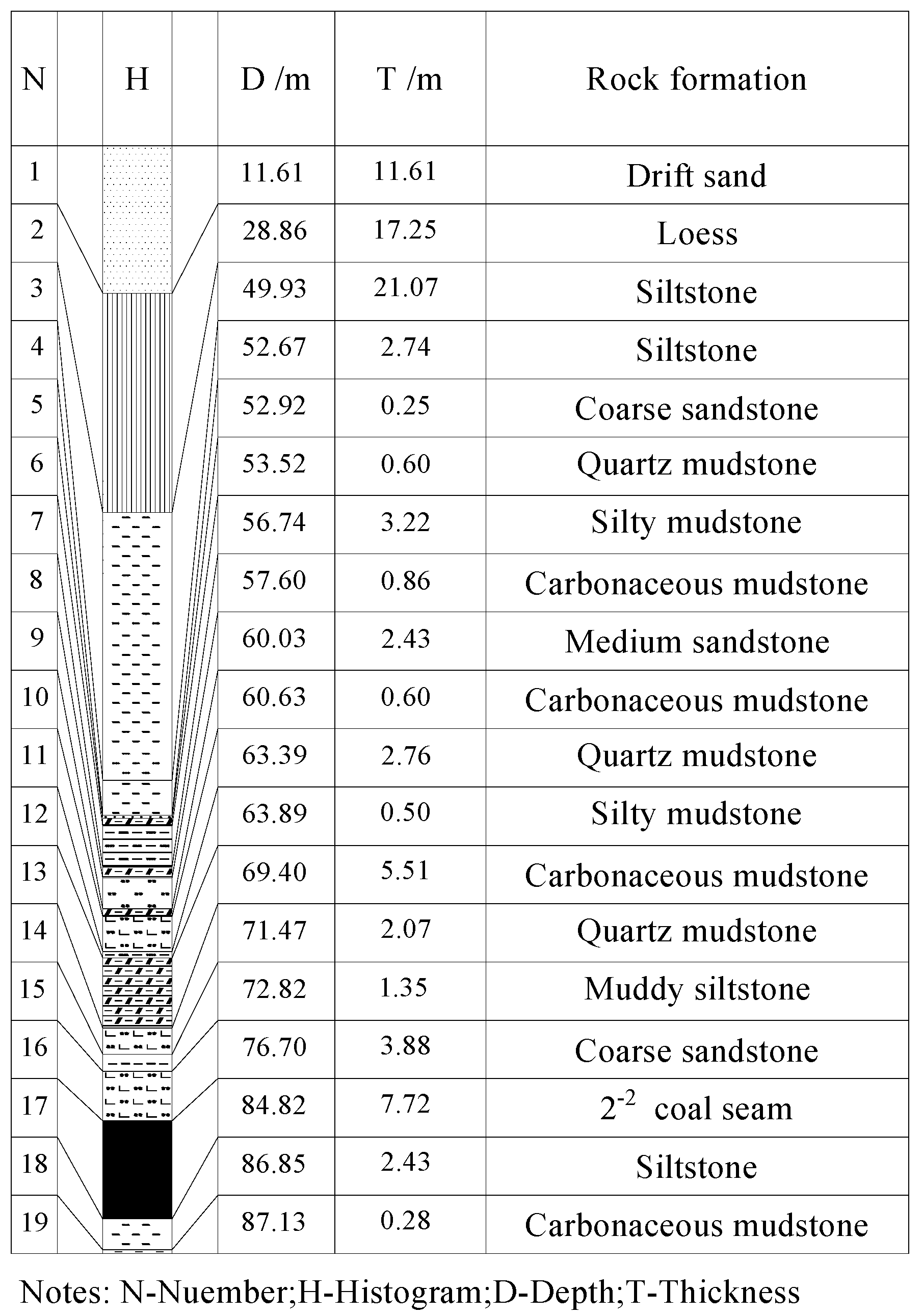
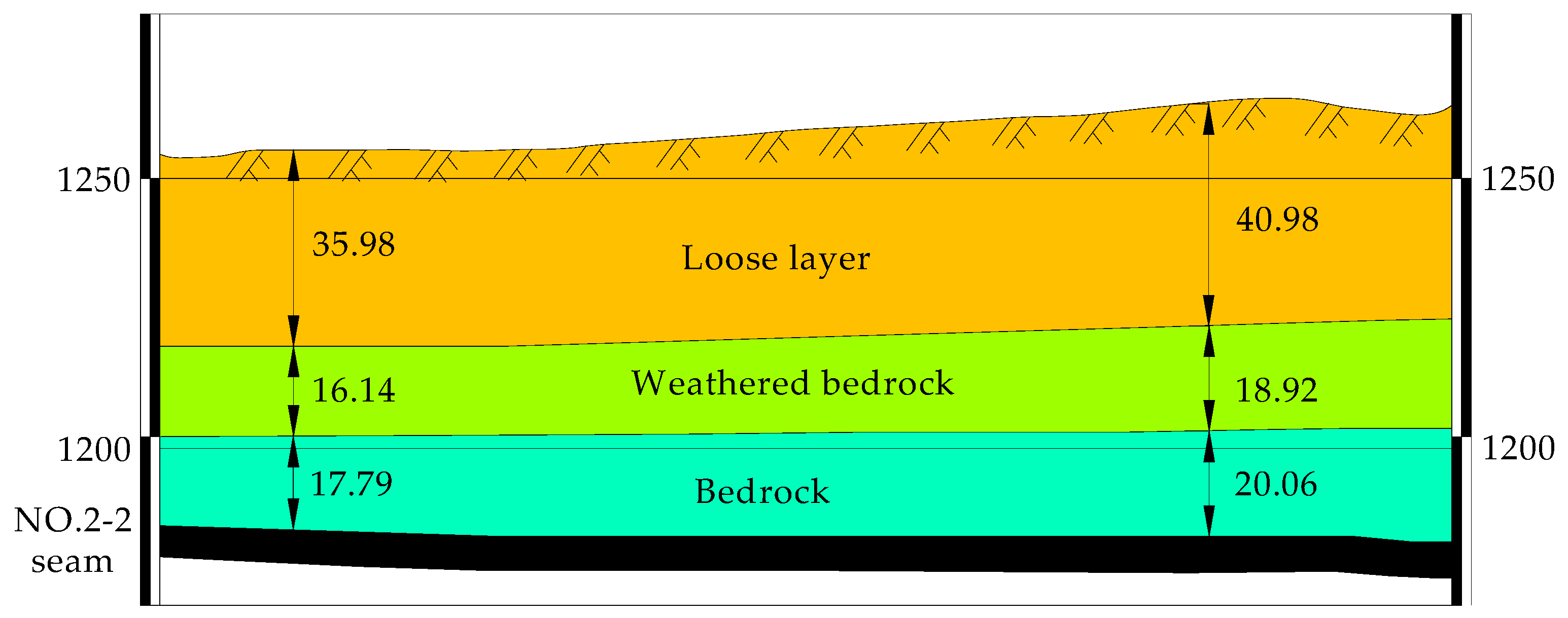
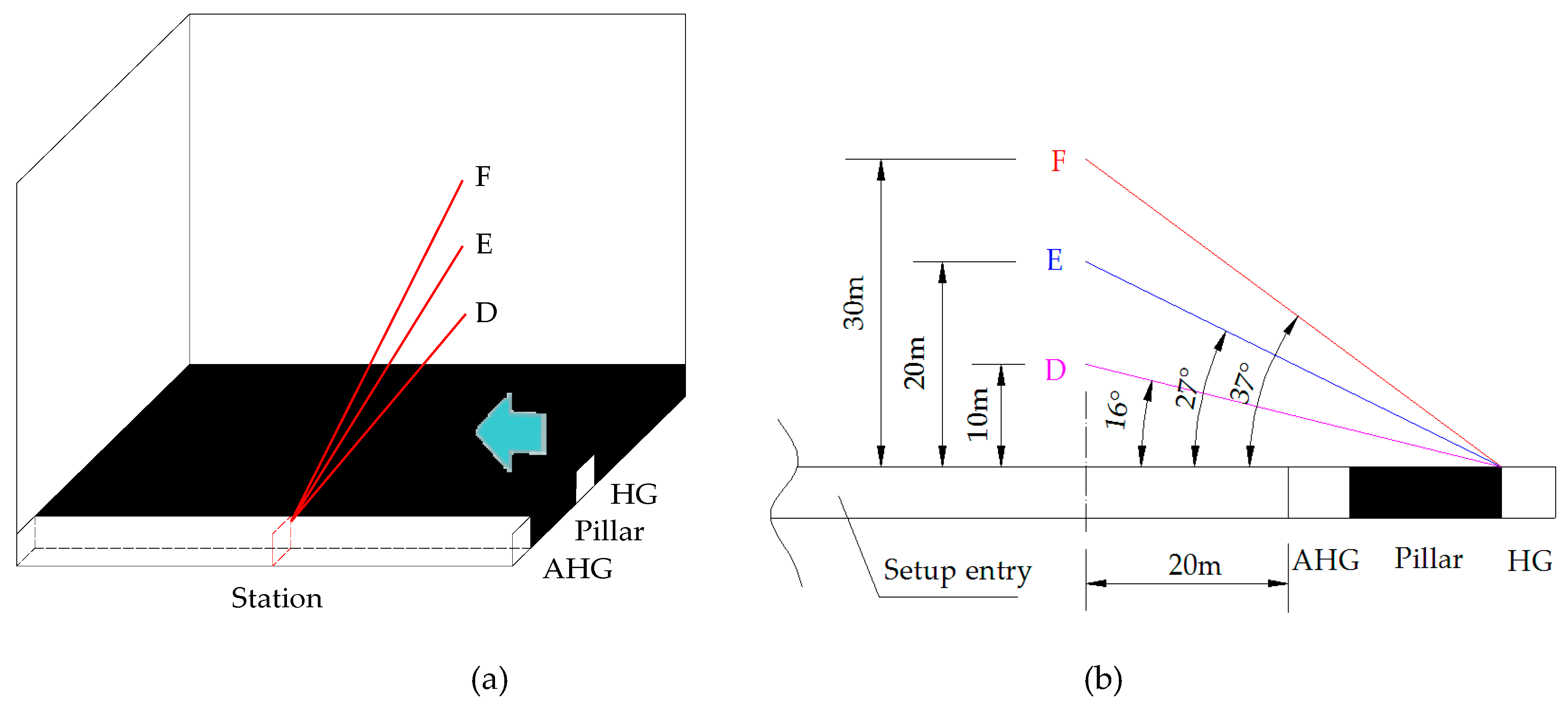


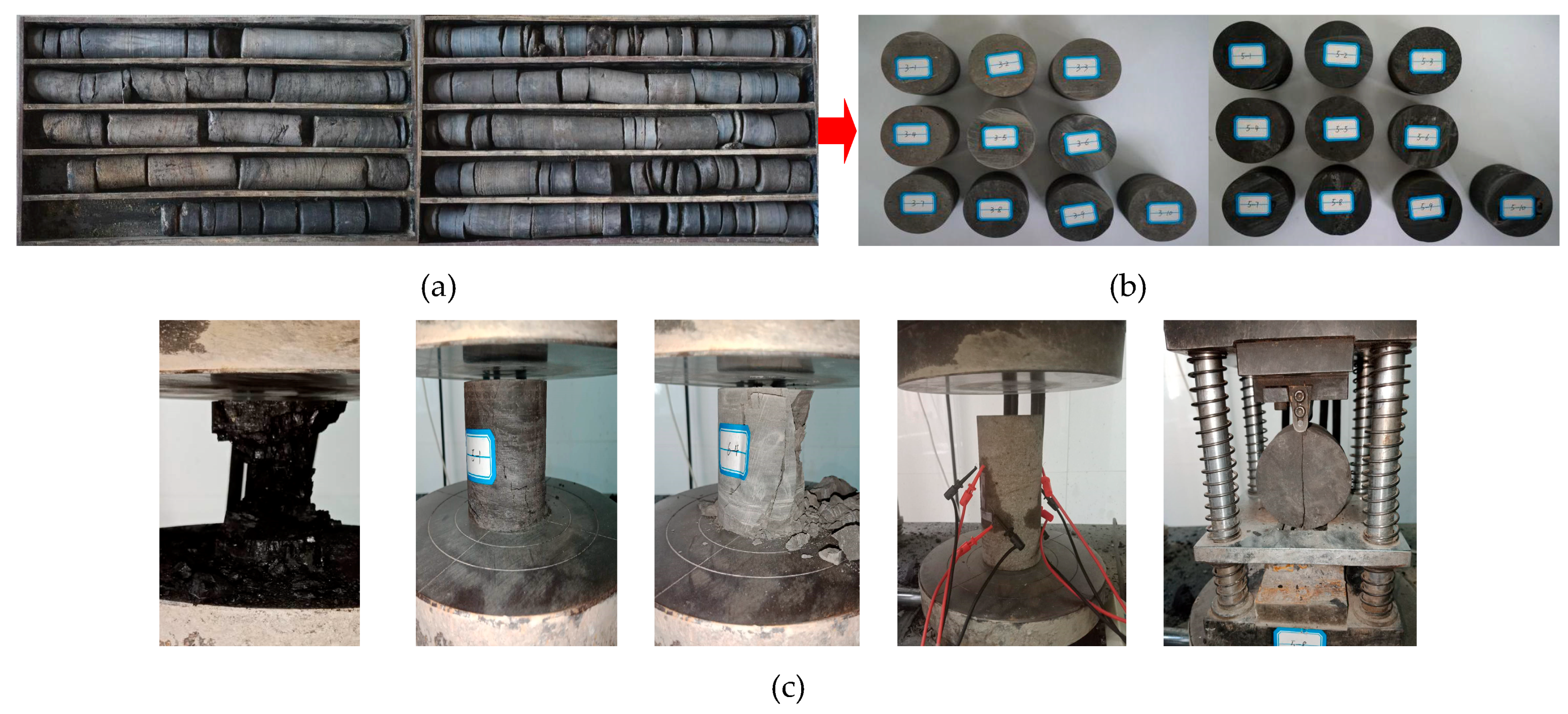

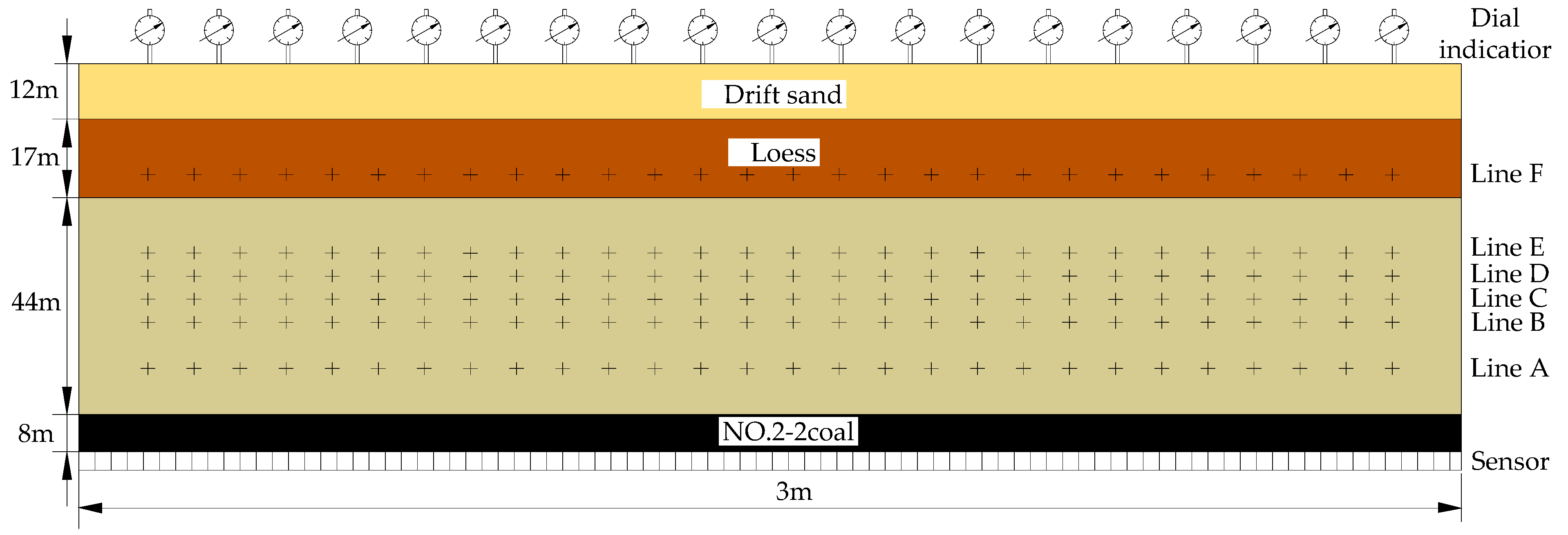

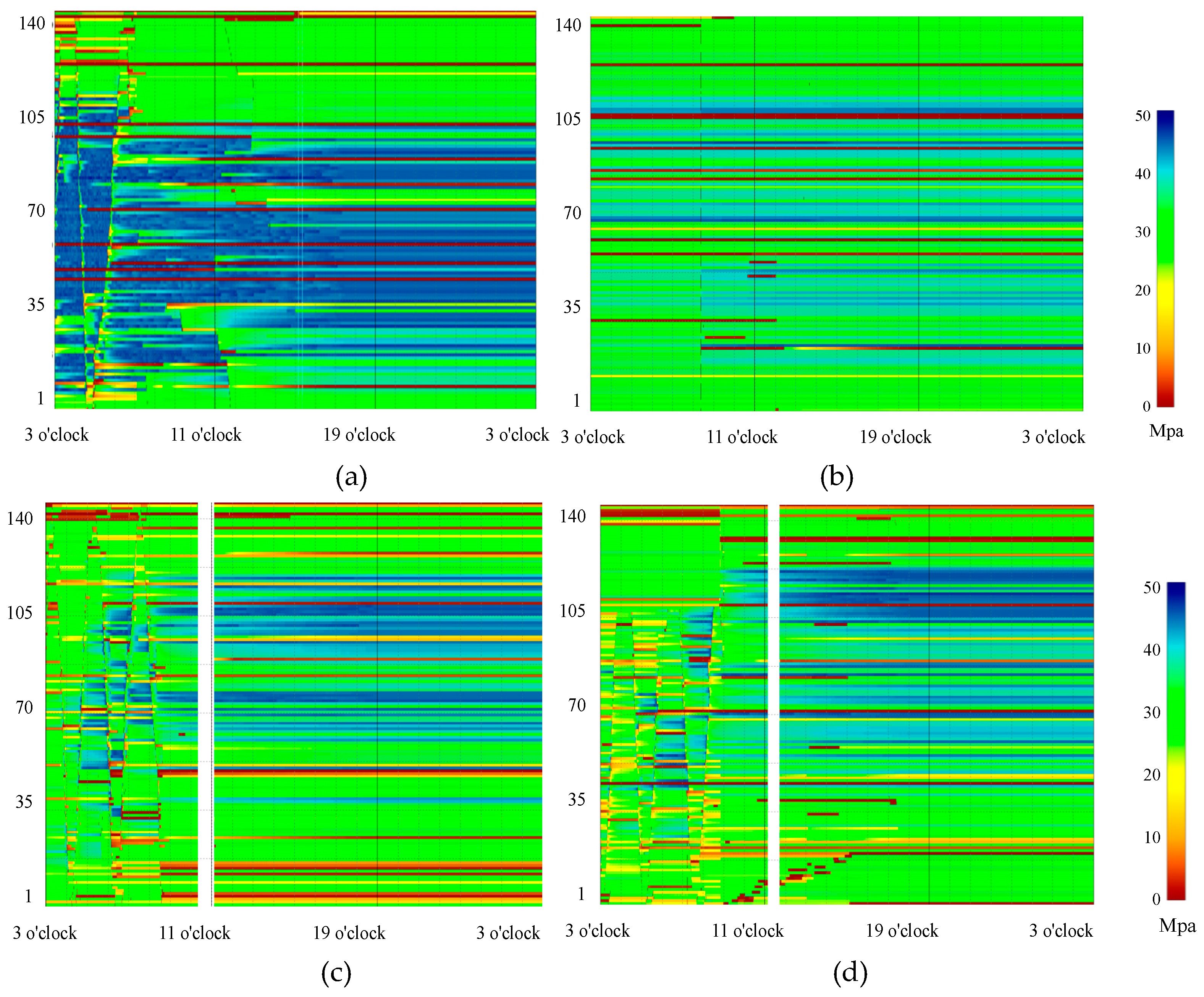

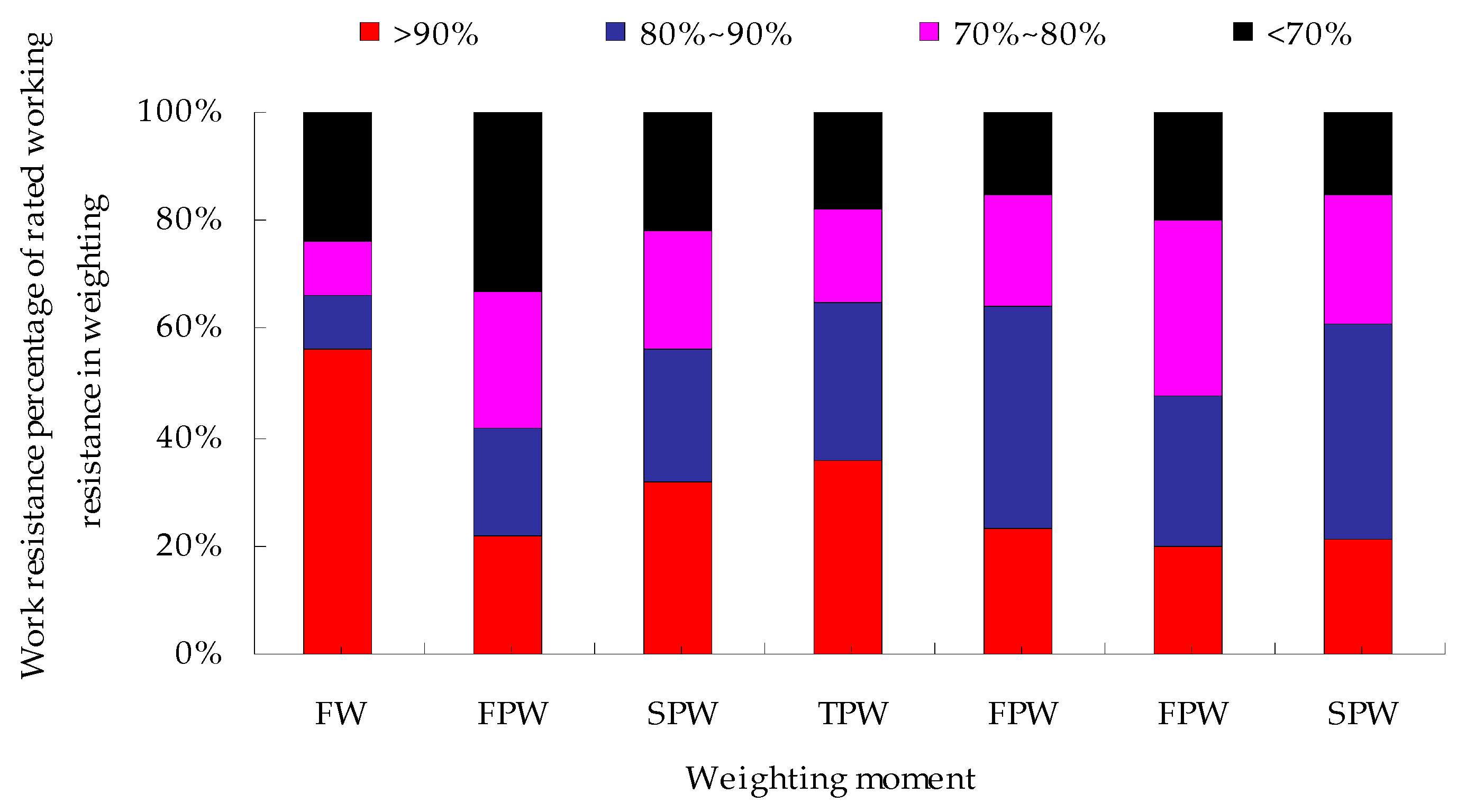
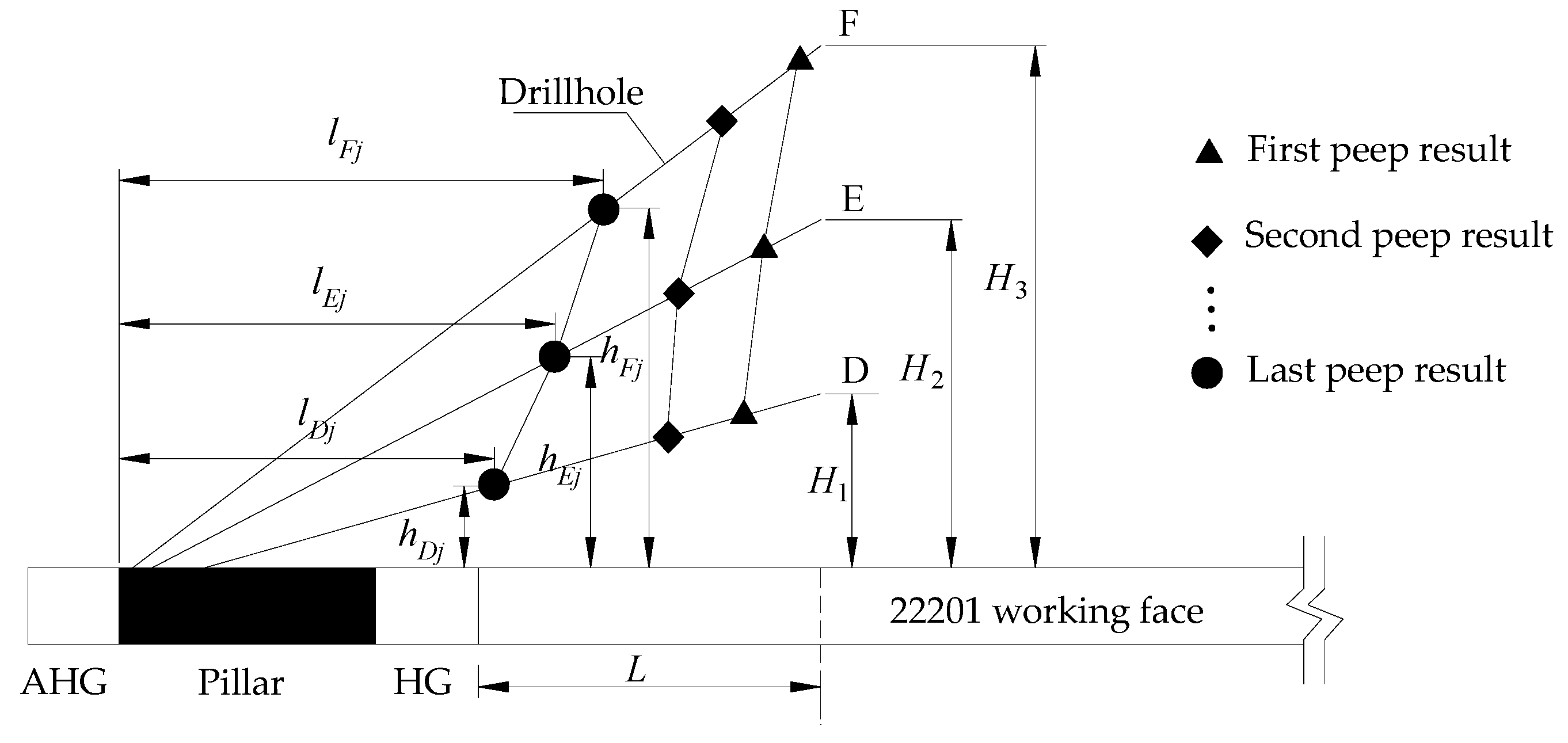
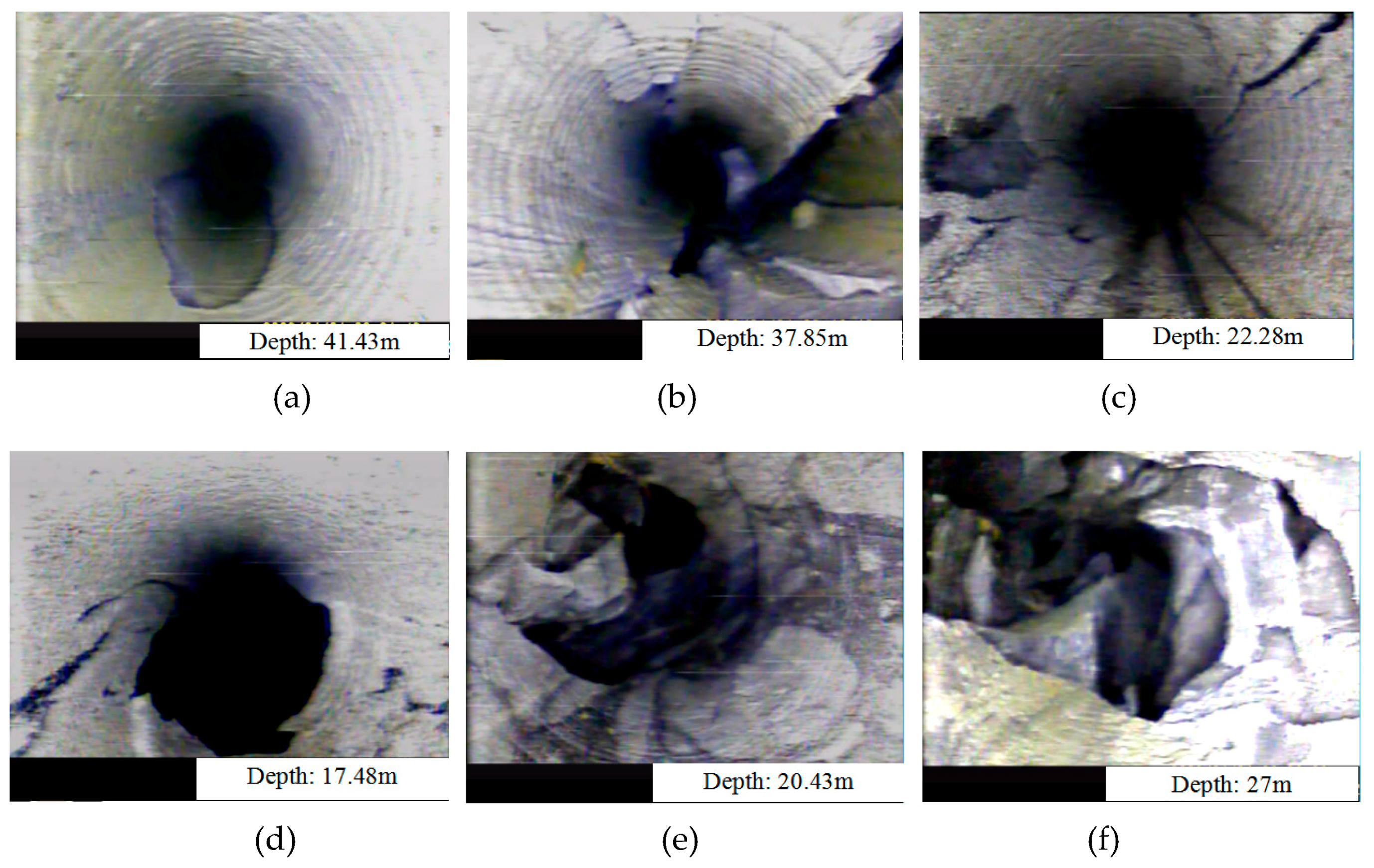

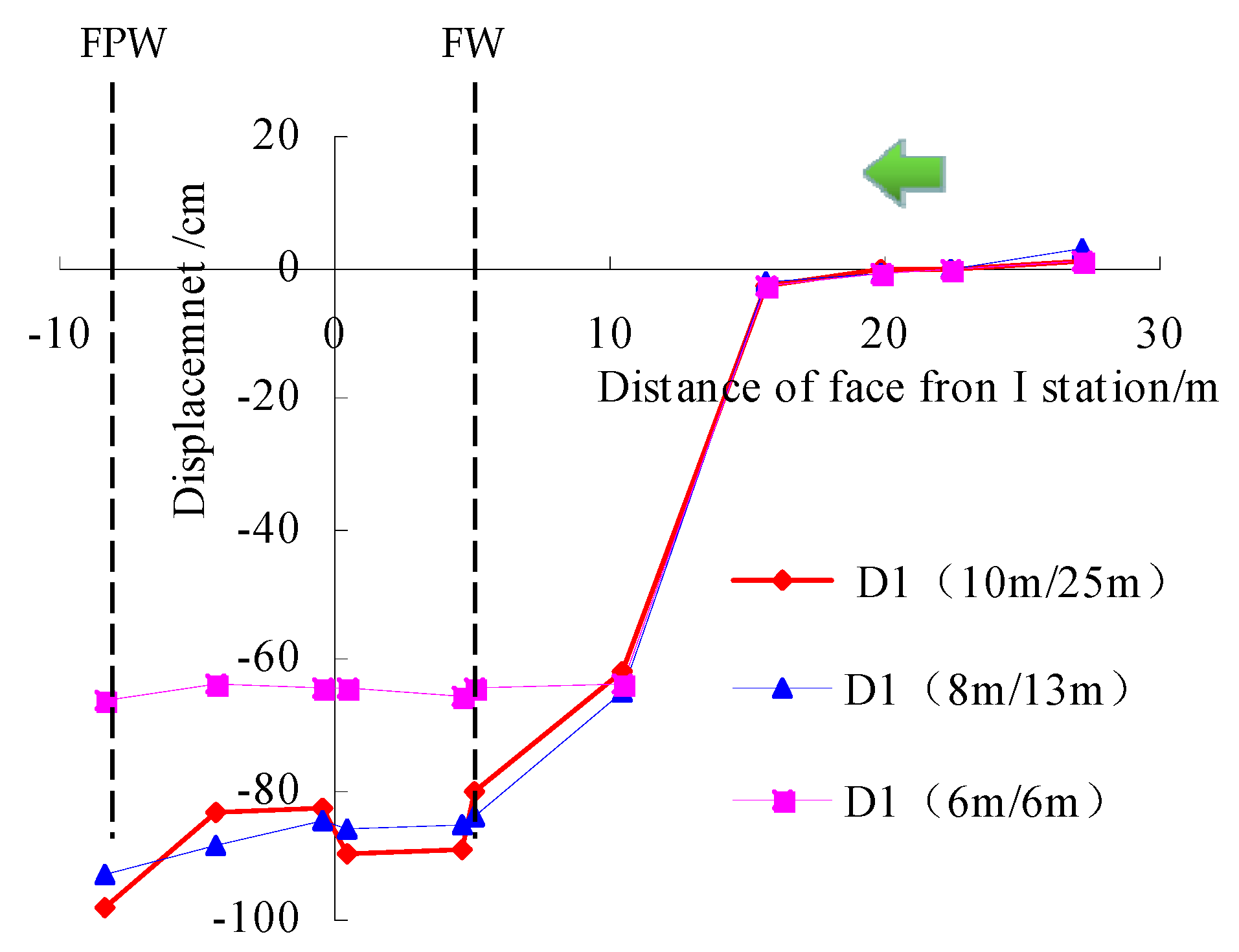

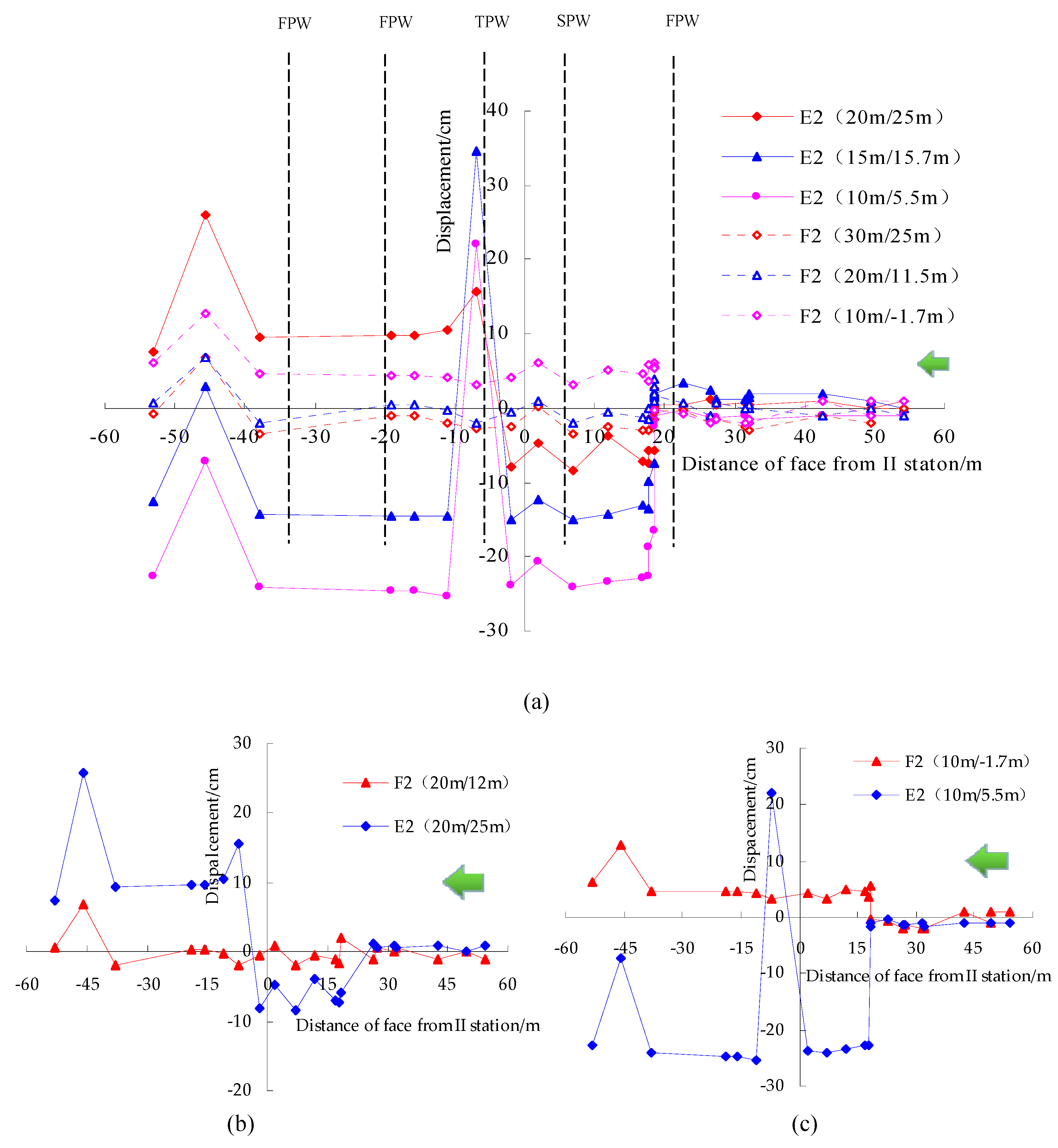
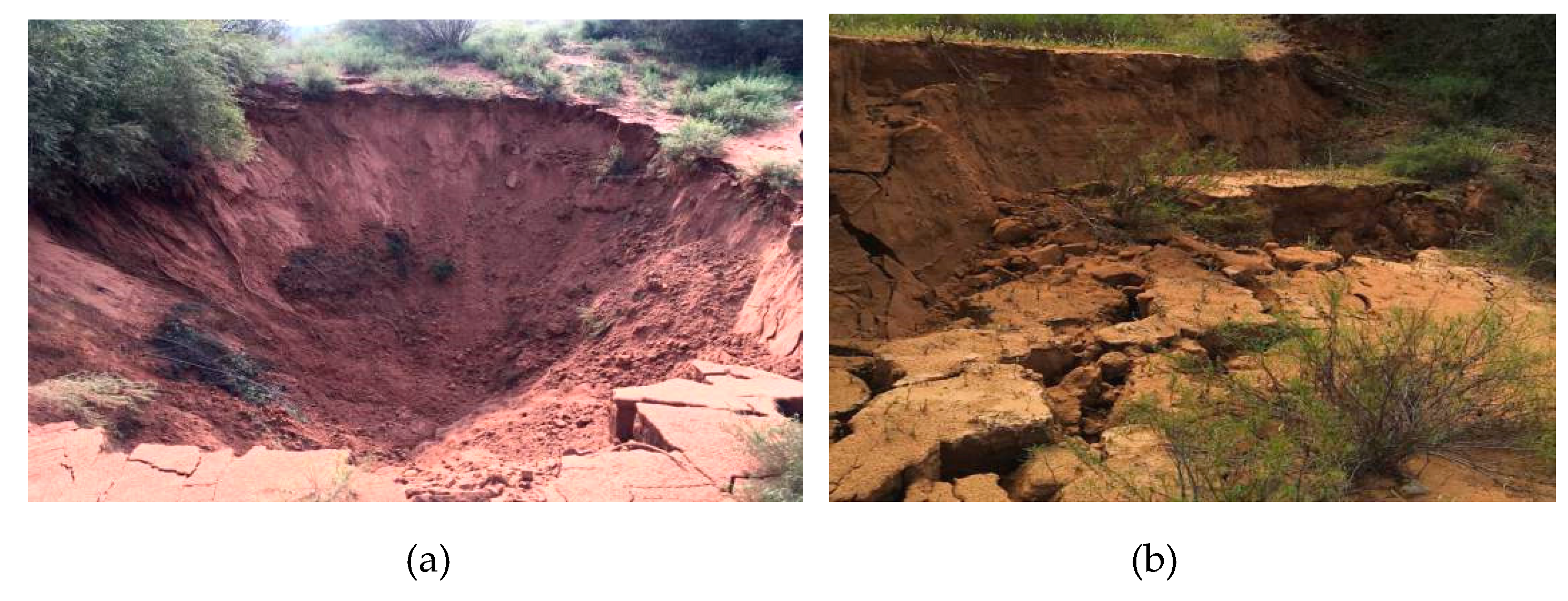

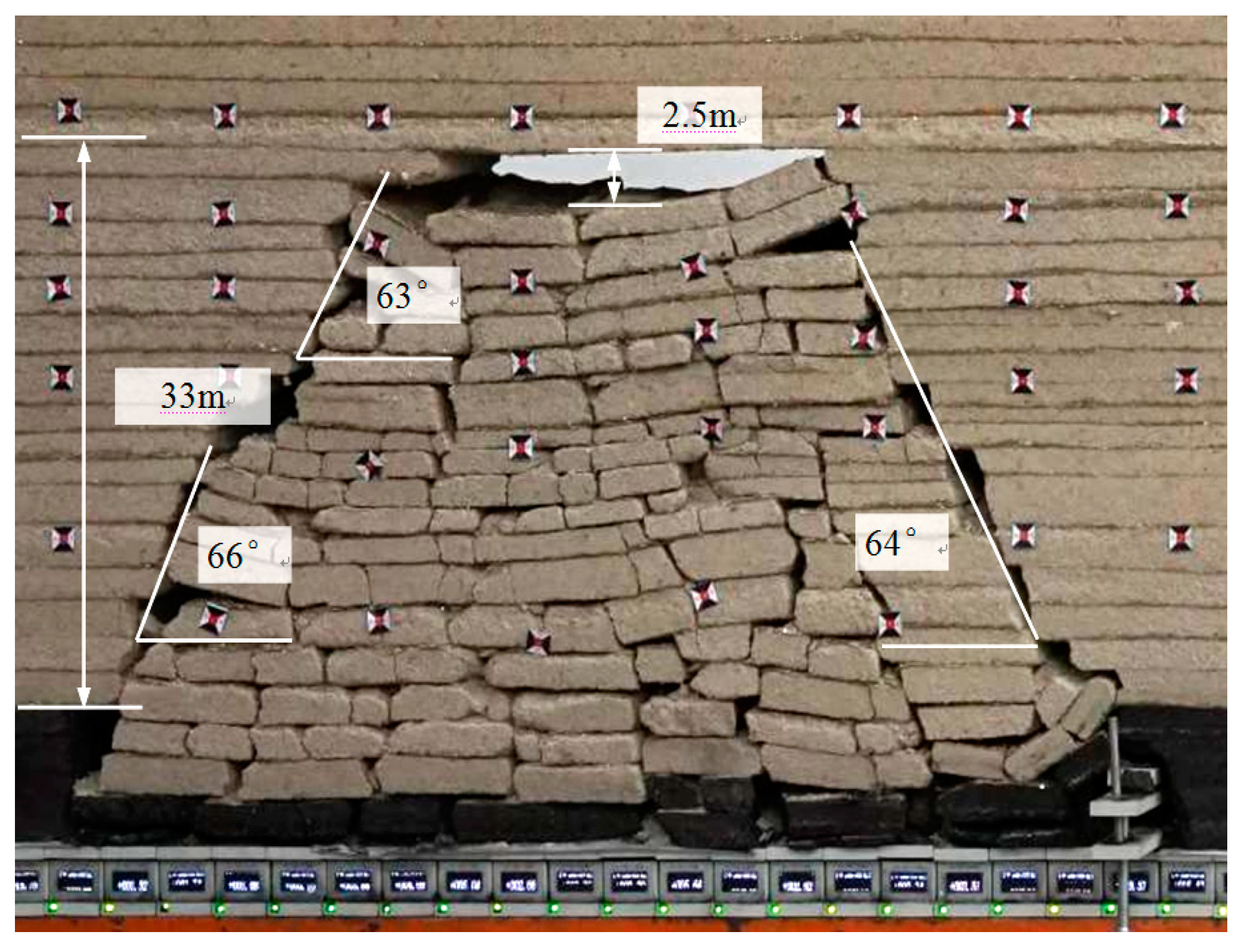

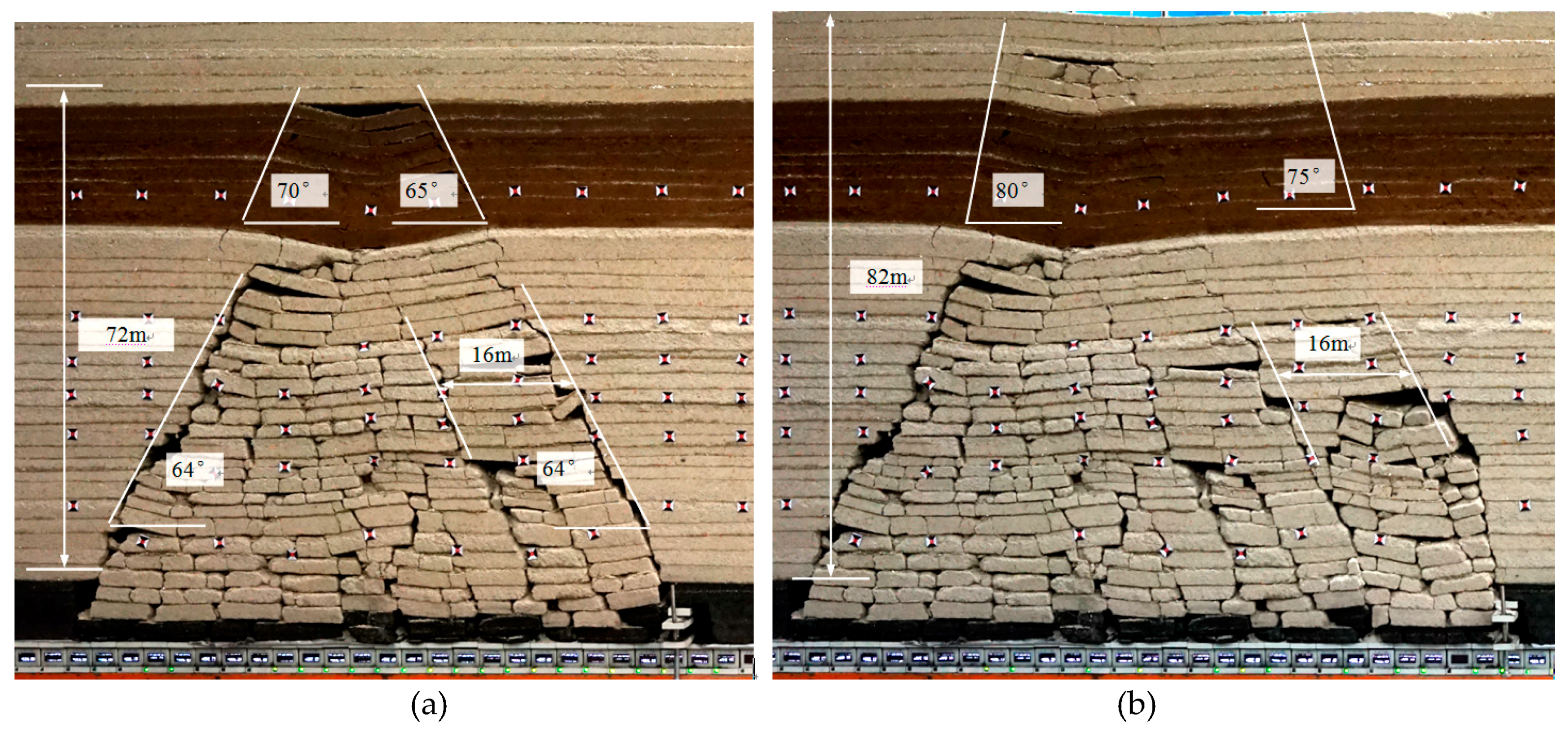
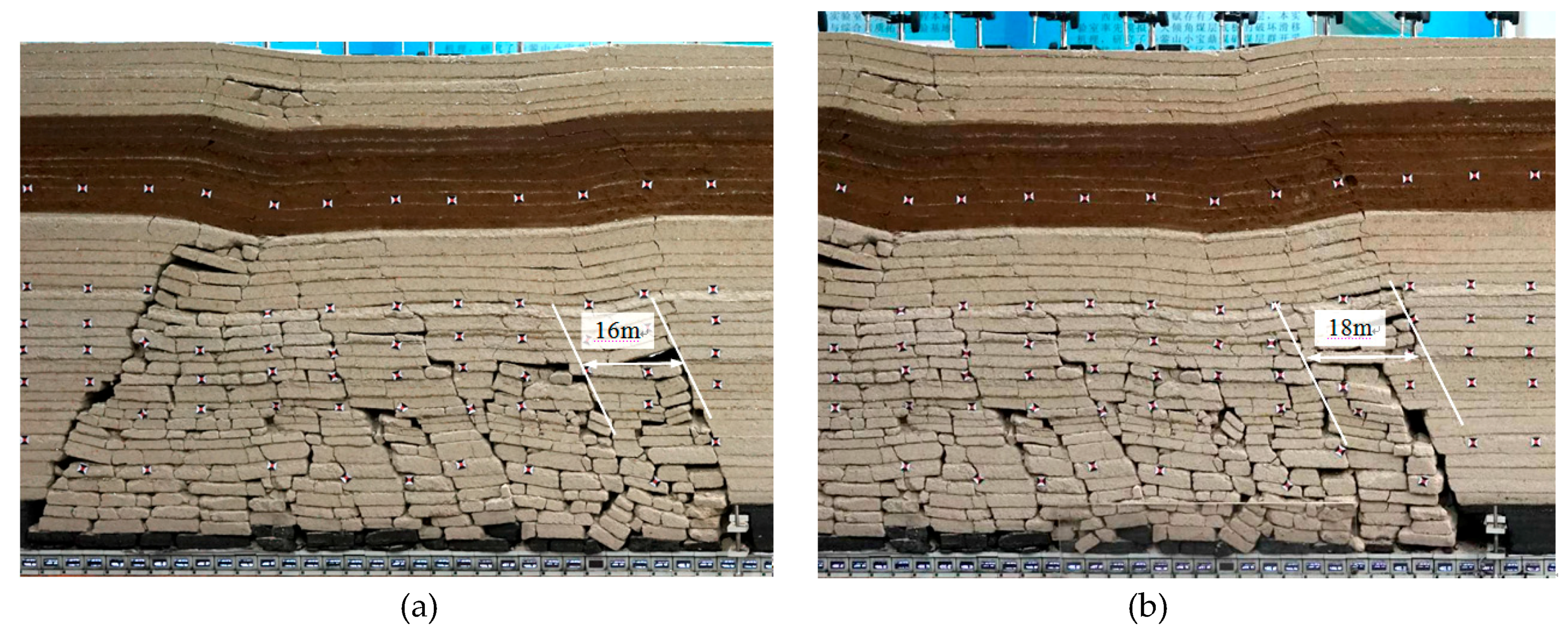

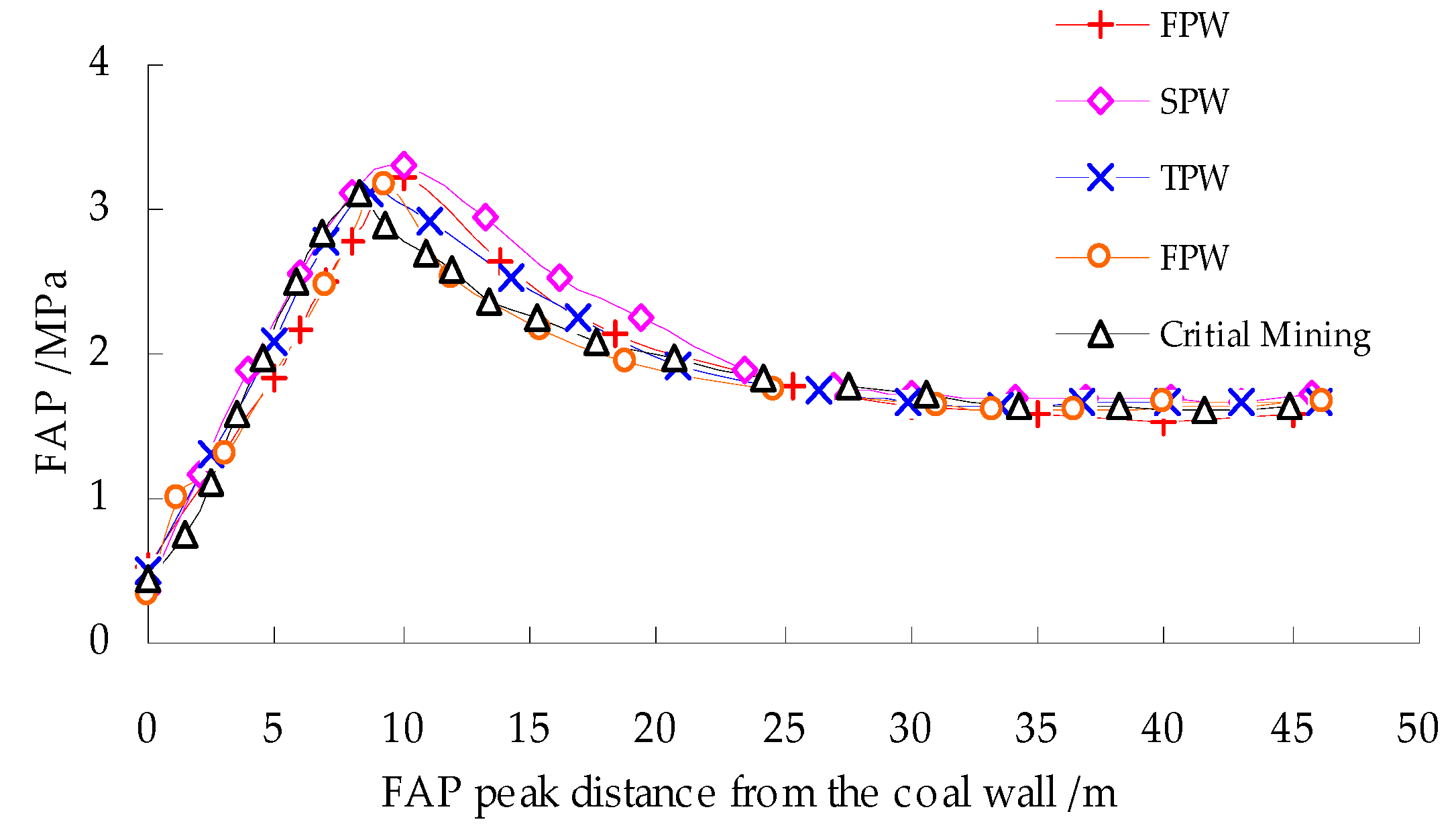
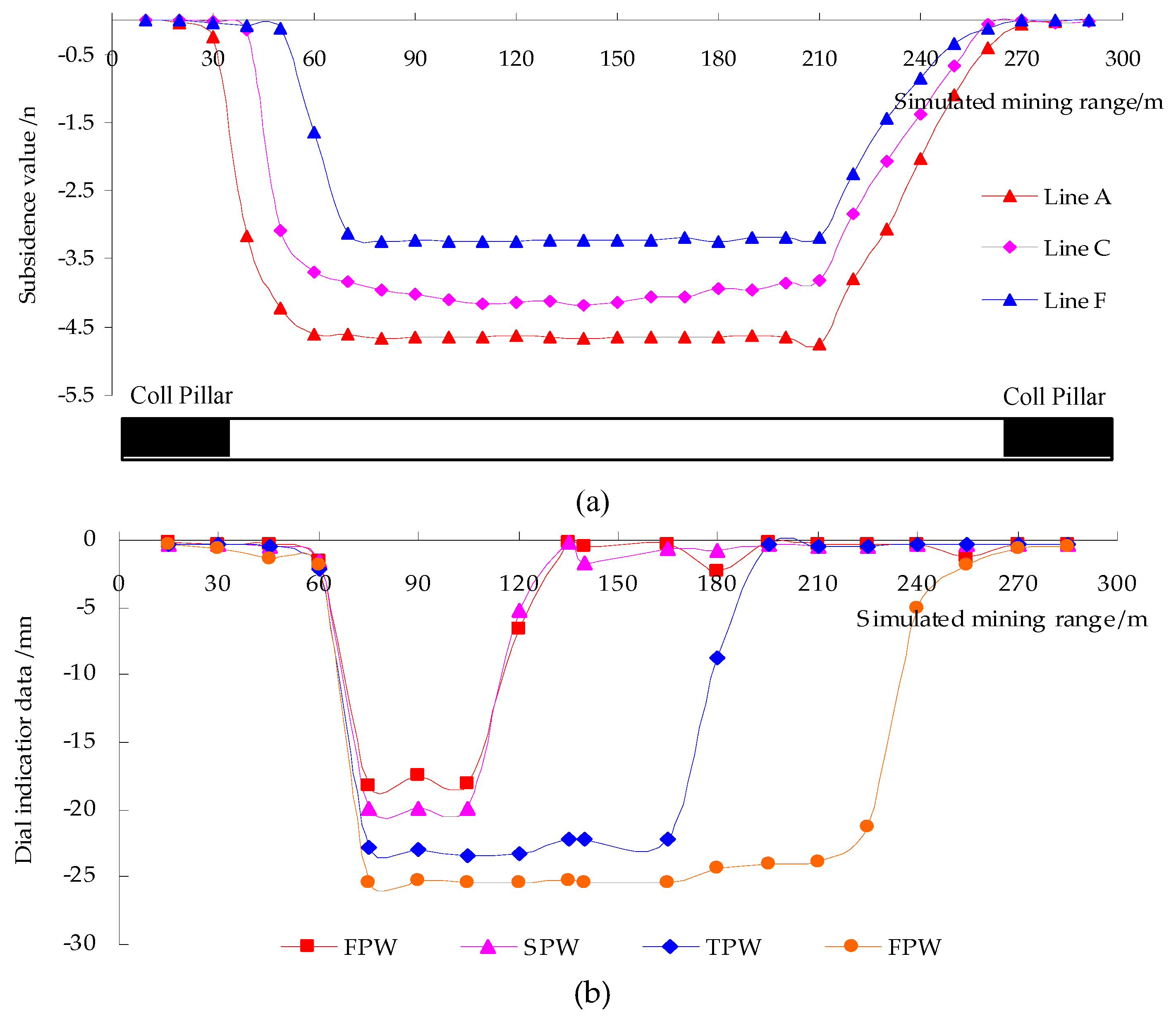
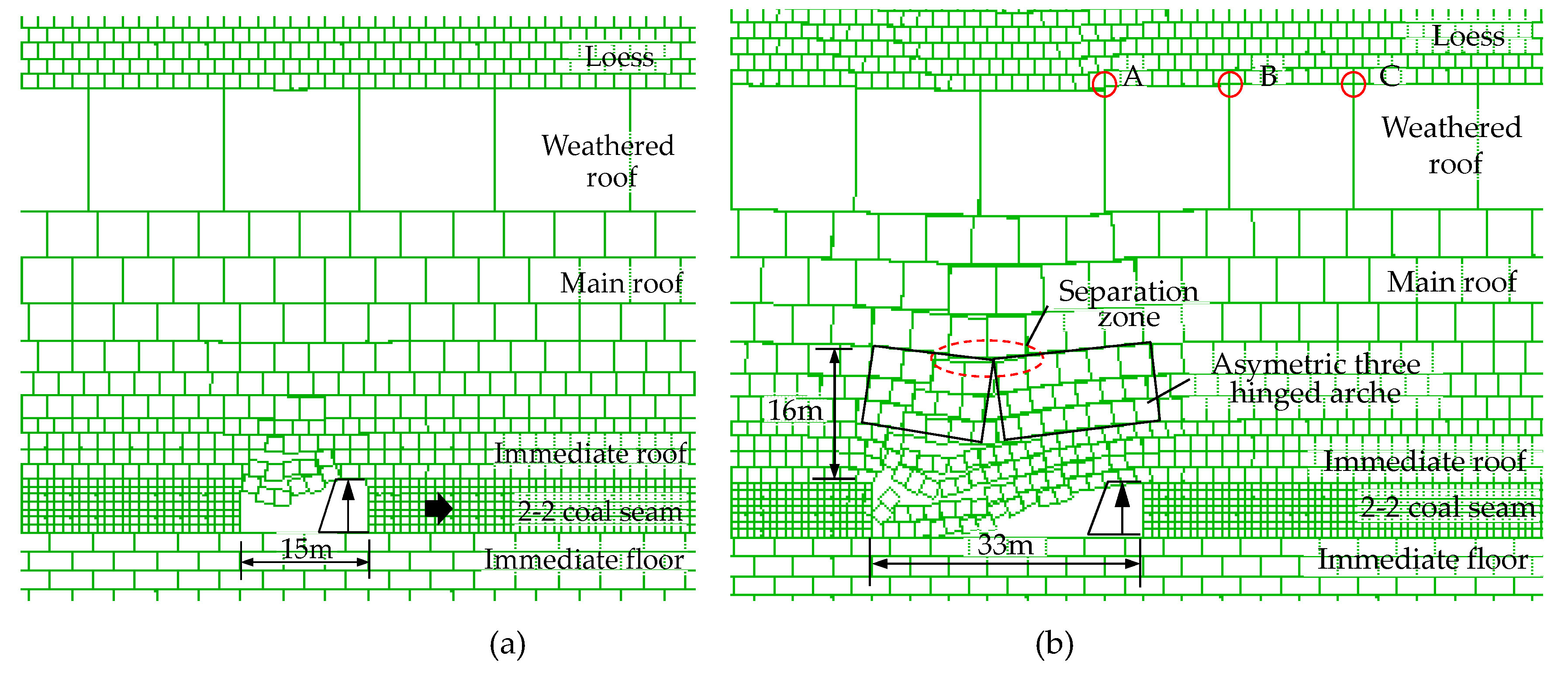
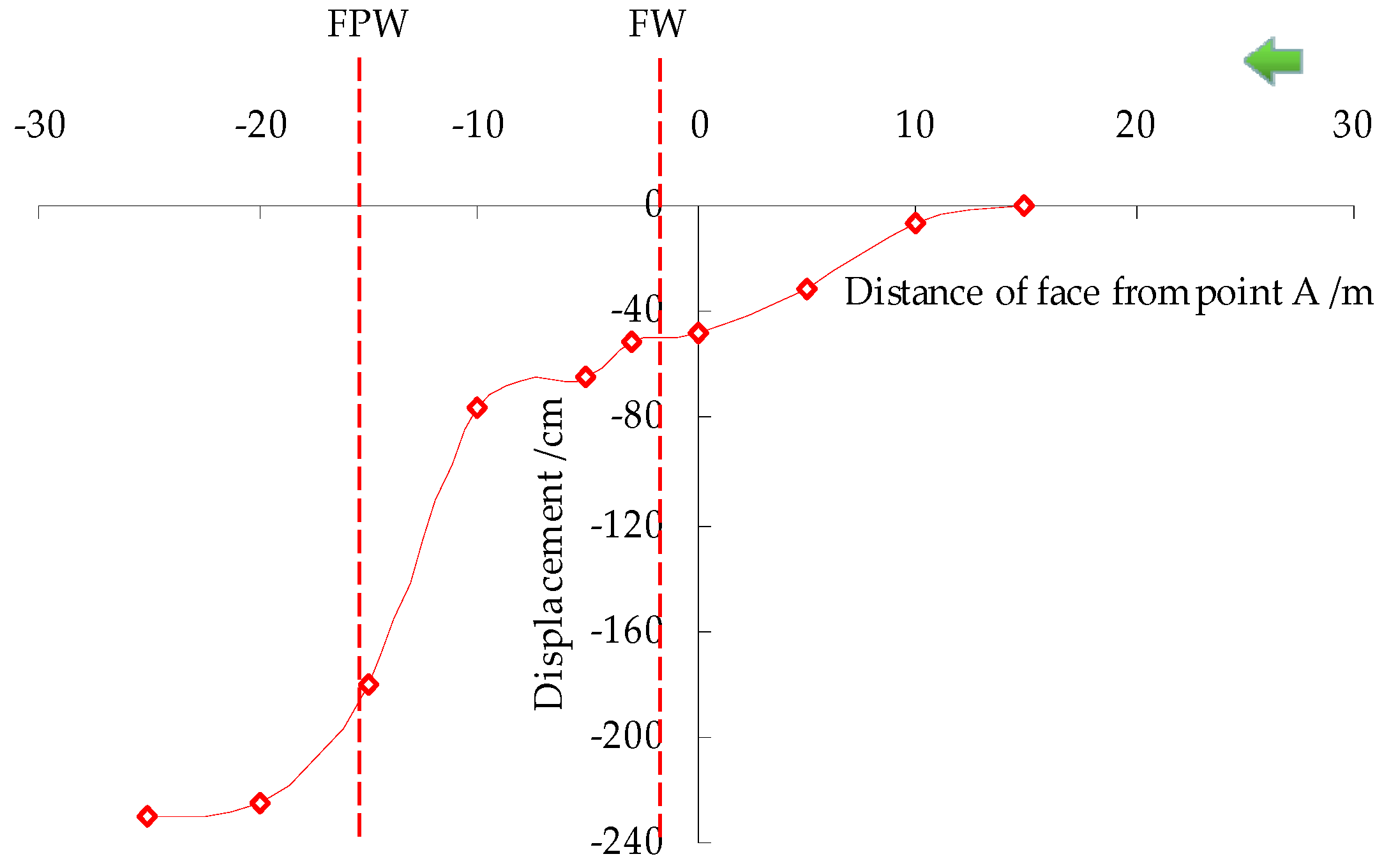

| Lithology | Bulk Density (kg/m3) | Compressive Strength (MPa) | Elastic Modulus ×104 (MPa) | Poisson’s Ratio | Cohesion (MPa) | Internal Friction Angle | Tensile Strength (MPa) |
|---|---|---|---|---|---|---|---|
| Coal | 1.32 | 35.57 | 2827 | 0.19 | / | / | / |
| Coarse sandstone | 2.68 | 18.94 | 2217 | 0.22 | 1.40 | 31.97 | 0.46 |
| Muddy siltstone | 2.45 | 39.04 | 7588 | 0.14 | 4.95 | 34.29 | 1.82 |
| Mudstone | 2.40 | 31.57 | 2956 | 0.19 | 4.29 | 32.59 | 1.18 |
| Carbonaceous mudstone | 2.17 | 19.79 | 2618 | 0.21 | 2.60 | 31.72 | 1.72 |
| Siltstone | 2.41 | 22.16 | 2901 | 0.20 | 2.79 | 32.67 | 1.04 |
| Weathered siltstone | 2.11 | 12.27 | 3729 | 0.18 | 1.75 | 30.47 | 0.47 |
| Lithology | Match Ratio Number | Consumables (kg) | |||
|---|---|---|---|---|---|
| Sand | Gypsum | Calcium Carbonate | Coal Ash | ||
| Drif sand | Sand:Calcium Carbonate=9:1 | 8.64 | / | 0.96 | |
| Loess | Sand: Soil: Oil=4.5:4.5:1 | Sand (8.64) : Soil (8.64) : Oil (1.92) | |||
| Silt stone | 746 | 8.40 | 0.48 | 0.72 | |
| Silt stone | 737 | 8.40 | 0.36 | 0.84 | |
| Coarse sandstone | 728 | 8.40 | 0.24 | 0.96 | |
| Medium sandstone | 646 | 8.23 | 0.55 | 0.82 | |
| Quartz mudstone | 646 | 8.23 | 0.55 | 0.82 | |
| Carbonaceous mudstone | 737 | 8.40 | 0.36 | 0.84 | |
| Quartz mudstone | 646 | 8.23 | 0.55 | 0.82 | |
| Muddy siltstone | 746 | 8.40 | 0.48 | 0.72 | |
| Coarse sandstone | 646 | 8.23 | 0.55 | 0.82 | |
| No. 2−2 seam | 20:20:1:5 | 3.80 | 0.19 | 0.95 | 3.80 |
© 2019 by the authors. Licensee MDPI, Basel, Switzerland. This article is an open access article distributed under the terms and conditions of the Creative Commons Attribution (CC BY) license (http://creativecommons.org/licenses/by/4.0/).
Share and Cite
Huang, Q.; He, Y. Research on Overburden Movement Characteristics of Large Mining Height Working Face in Shallow Buried Thin Bedrock. Energies 2019, 12, 4208. https://doi.org/10.3390/en12214208
Huang Q, He Y. Research on Overburden Movement Characteristics of Large Mining Height Working Face in Shallow Buried Thin Bedrock. Energies. 2019; 12(21):4208. https://doi.org/10.3390/en12214208
Chicago/Turabian StyleHuang, Qingxiang, and Yanpeng He. 2019. "Research on Overburden Movement Characteristics of Large Mining Height Working Face in Shallow Buried Thin Bedrock" Energies 12, no. 21: 4208. https://doi.org/10.3390/en12214208
APA StyleHuang, Q., & He, Y. (2019). Research on Overburden Movement Characteristics of Large Mining Height Working Face in Shallow Buried Thin Bedrock. Energies, 12(21), 4208. https://doi.org/10.3390/en12214208





